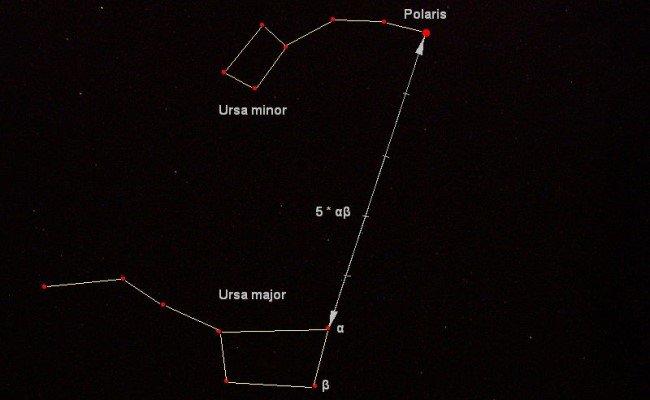How to Find the North Star

Discover how to find the North Star with our helpful guide. Learn the tips and tricks to locate this celestial beacon in the night sky.
Famous for its seemingly unwavering position in the sky, the North Star has been a beacon for travelers, sailors, and stargazers alike for centuries. But what is it that makes this star so special – and where exactly is it? In this article, we’ll share some handy tips on how to find the North Star and uncover some of its history and mysteries.
What Is the North Star?
The North Star, or Polaris, is a star that resides approximately 433 light-years away in the constellation Ursa Minor. What sets it apart from other stars is its unique position – almost directly above the North Pole. As a result, it remains stationary throughout the night while other stars appear to move in circular paths around it.
From ancient mariners to intrepid explorers, the North Star has held a place of prominence in human history. Civilizations such as the Phoenicians and Vikings relied heavily on Polaris for navigation. By aligning their ships with the North Star, they could maintain their course even in the darkest nights.
Additionally, the North Star has found its way into numerous myths and legends. In Greek mythology, sailors believed the gods had placed the North Star in the sky to safely guide them home. Ancient Chinese astronomers also revered it as the celestial emperor, holding court over the heavens.
By learning to identify Polaris, you’ll connect yourself with centuries of human culture and exploration – and gain a pretty handy natural compass too!
Modern-Day Relevance of the North Star
In today’s age of GPS and digital navigation, you might wonder why the North Star still matters. Well, despite technological advancements, Polaris continues to serve as a crucial point of reference for astronomers and outdoor enthusiasts alike. It’s particularly useful in remote areas where electronic devices may fail, and phone signals are patchy.
What’s more, the North Star holds a significant place in popular culture. Songs, poems, and films have all referenced Polaris as a symbol of guidance and steadfastness. So, whether you’re a sailor navigating the seas or a poet seeking inspiration, the North Star remains a guide to all!
The Science Behind the North Star
What makes Polaris so special that it remains relatively fixed in the sky? The answer lies in its unique relative position, almost directly above the Earth’s rotational axis. While other stars appear to move across the sky due to Earth’s rotation, Polaris stays put, serving as a reliable celestial anchor.
It’s also interesting to note that Polaris is not a single star but a multiple-star system consisting of Polaris Aa, Polaris Ab, and Polaris B. The primary star, Polaris Aa, is a supergiant approximately 2,500 times more luminous than our Sun. Combined with its strategic location, this brightness is also part of what makes Polaris the perfect navigational star.
How to Find the North Star
When you first try and learn how to find the North Star, it can seem like a pretty big challenge! Indeed, many people believe the star is among the brightest in our night sky, but it’s only the 48th brightest. You might then think that locating Polaris could be pretty tough work. Well, thankfully, we have a few tricks up our sleeve!
- Identify the Big Dipper: For starters, you’ll want to find the Big Dipper (also known as the Plough in the UK). This is a famous (and easily identifiable) asterism in the constellation Ursa Major. You’ll be able to recognize it by its distinctive ladle shape.
- Use the Pointer Stars: The two stars at the end of the Big Dipper’s ‘bowl‘ will be your next target. These stars are Dubhe and Merak, also known as the Pointer Stars. Now, draw an imaginary line through these stars and extend it outwards.
- Locate Polaris: Follow the line you made from the Pointer Stars, and you’ll soon reach Polaris, which sits at the end of the handle of the Little Dipper (Ursa Minor). Unlike other stars, Polaris appears almost stationary in the sky, making it a reliable guide.
This task can prove a little easier or harder, depending on the time of year. While the North Star is always visible in the northern hemisphere, some constellations can be more or less visible at different times of the year. In the case of the Big Dipper, the asterism is most visible in April and more difficult to spot in the autumn.
Star Maps
If you can’t spot the Big Dipper and you’re wondering how to find the North Star, there is another way! By using a star chart or a star map app, like the OSR Star Finder, you can easily identify the location of Polaris in relation to other constellations.
The Future of Polaris
While Polaris has been a reliable guide for centuries, changes in the Earth’s axis over millennia could alter its position in the night sky. This phenomenon, known as axial precession, means that in about 13,000 years, another star will replace Polaris as the North Star. However, for our lifetimes and many generations to come, Polaris will continue to be the celestial anchor we’ve come to rely on.
Polaris is currently a yellow supergiant, a stage it could remain in for another couple of thousand years. But soon (universally speaking), it will transition into a red giant. After spending up to about four million years as a red giant, Polaris will become a white dwarf. Luckily for us, this process will take place over millions of years, so we can continue using it as our celestial guide for many generations to come!
OSR Star Finder

The North Star has guided adventurers, inspired storytellers, and stood as a beacon of inspiration throughout human history. Whether you’re an aspiring astronomer, an adventurous stargazer, or simply curious about the night sky, understanding how to find Polaris can enrich your celestial experiences.
And remember, by using the OSR Star Finder App, you can easily identify Polaris and other important stars in the night sky. So grab a blanket, head outside on a clear night, and let the North Star guide you on your journey through the universe!


